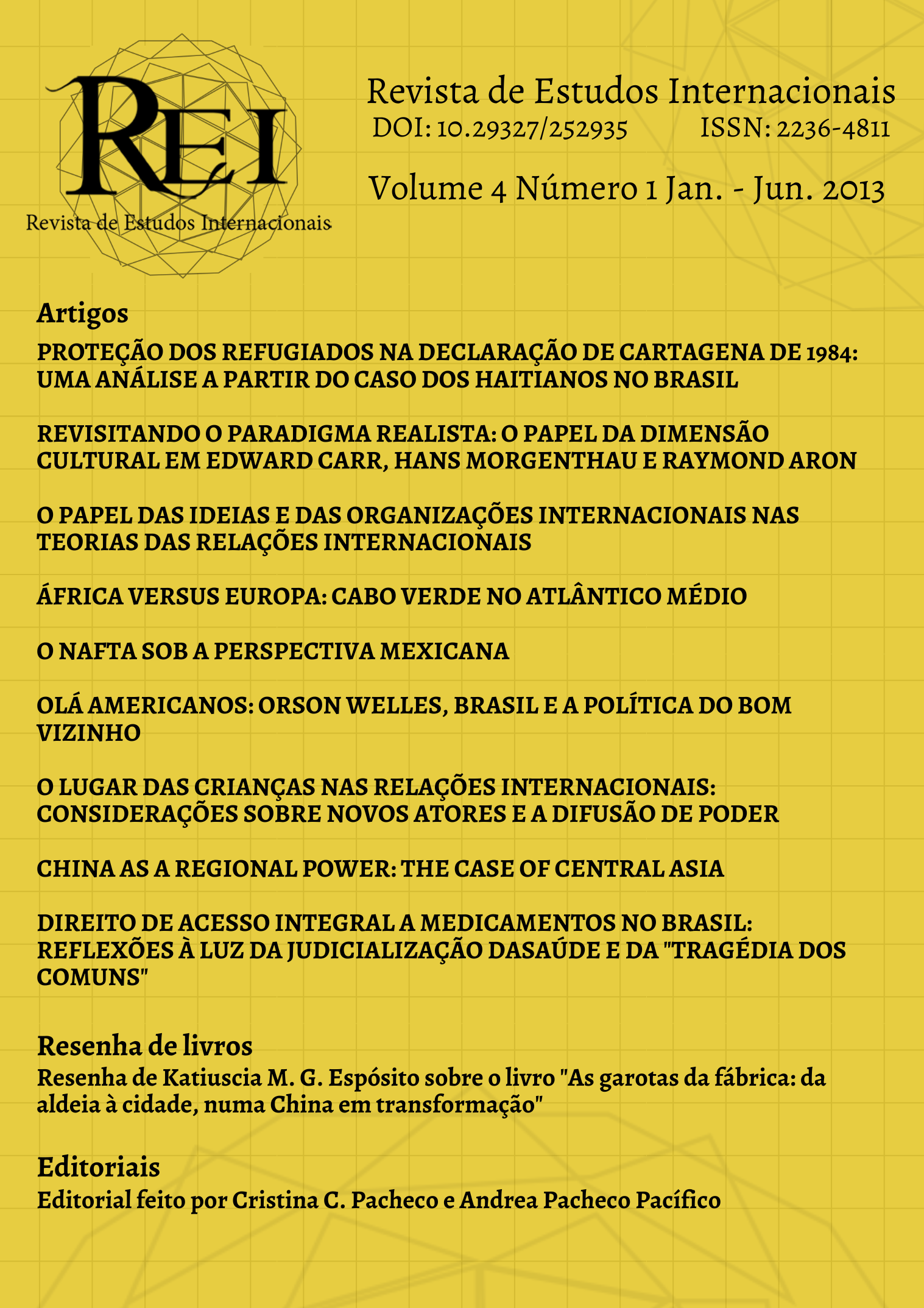O LUGAR DAS CRIANÇAS NAS RELAÇÕES INTERNACIONAIS: CONSIDERAÇÕES SOBRE NOVOS ATORES E A DIFUSÃO DE PODER
Palavras-chave:
Crianças, Relações Internacionais, Agência, Atores, Agente-estruturaResumo
Esse artigo discute a atuação das crianças como um grupo social a ser considerado nas Relações Internacionais, entendendo em que lugar elas se inserem na disciplina. Esse trabalho pretende responder se é possível estudar as crianças como participates das Relações Internacionais e, em caso positivo, porque a disciplina não evidencia essa participação. Discutem-se inicialmente algumas concepções do conceito de criança e como as teorias das Relações Internacionais entendem os atores e sua agência internacional. Também se aborda a visão de agência invisível caracterizada por Cynthia Enloe e as considerações de Alison M. S. Watson sobre como as RI veem as crianças para mostrar que as crianças possuem uma agência invisível que não é reconhecida nas Relações Internacionais.
Referências
AVANT, Deborah; FINNEMORE, Martha; SELL, Susan (2010). Who governs the globe? New York: Cambridge University Press.
BOYDEN, Jo (2001). Children’s participation in the context of forced migration. PLA Notes, Issue 42: 52–6.
BROCKLEHURST, Helen (2009). Childhood in Conflict: Can the Real Child Soldier Please Stand Up?. Ethics, Law and Society, IV (259): 259-70.
CARR, Edward Hallet (2001). Vinte Anos de Crise: 1919-1939. Uma Introdução ao Estudo das Relações Internacionais. Brasília: Editora Universidade de Brasília.
DEL FELICE, Celina; WISLER, Andria (2007). The Unexplored Power and Potential of Youth as Peace-builders. Journal of Peace Conflict & Development. Issue 11, November.
DUBINSKY, Karen (2012). Children, Ideology, and Iconography: How Babies Rule the World. The Journal of the History of Childhood and Youth, 5 (1): 5-13.
ENLOE, Cynthia (1990). Bananas, Beaches and Bases: Making Feminist Sense of International Politics. Berkeley: University of California Press.
ESTADÃO (2013). Adolescente Paquistanesa baleada pelo Talibã deixa o hospital. Publicado em [http://www.estadao.com.br/noticias/internacional,adolescente-paquistanesa-baleada-pelo-taleba- deixa-hospital,980514,0.htm]. Disponibilidade: 01/07/2014.
GERBAUDO, Paolo (2012). Tweets and the Streets. Social Media and Contemporary Activism. London: Pluto Press.
JEFLERESS, David (2012). Neither Seen Nor Heard: The Idea of the "Child" as Impediment to the Rights of Children. TOPIA: Canadian Journal of Cultural Studies, 75-97.
KECK, Margaret E.; SIKKINK, Kathryn (1998). Activists beyond boarders: advocacy networks in international politics. Ithaca e Londres: Cornell University Press.
KEOHANE, Robert O. (1998). Beyond Dichotomy: Conversations Between International Relations and Feminist Theory. International Studies Quarterly, 42 (1): 193-7.
LAKE, David (2010). Rightful rules: authority, order, and the foundations of global governance. International Studies Quarterly, 54: 587-613.
MANJIKIAN, Mary McEvoy (2010). From Global Village to Virtual Battlespace: The Colonizing of the Internet and the Extension of Realpolitik. International Studies Quarterly, 54: 381–401.
MCEVOY-LEVY, Siobhán (2001). Youth as Social and Political Agents: Issues in Post-Settlement Peace Building. Kroc Institute Occasional Paper, #21:OP:2. December.
NYE, Joseph S. Jr (2011). The Future of Power. New York: Public Affairs.
OKEREKE, Chukwumerije; BULKELEY, Harriet; SCHROEDER, Heike (2009). Conceptualizing Climate Governance Beyond the International Regime. Global Environmental Politics, 9 (l): 58- 78.
ONU (1989). Convenção das Nações Unidas sobre os Direitos da Criança, adotada pela Assembleia Geral das Nações Unidas em 20 de novembro de 1989. Publicado em [http://www.unicef.org/brazil/pt/resources_10120.htm]. Disponibilidade: 23/04/2013.
ONU (2012). Terceiro Protocolo Opcional a CRC sobre Procedimento de Comunicação. PUECHGUIRBA, Nadine (2004). Women and Children: Deconstructing a Paradigm. Seton Hall Journal of Diplomacy and International Relations, 5-20.
READ, Kay (2002). When Is a Kid a Kid? Negotiating Children's Rights in El Salvador's Civil War. History of Religions, 41 (4): 391-409.
RAMALHO DA ROCHA, Antônio Jorge (2002). Relações internacionais: teorias e agendas. Brasília: Funag/Ibri.
RISSE-KAPPEN, Thomas, Ed. (1995) .Bringing transnational relations back in: Non-state actors, domestic structures and international institutions. New York: Cambridge University Press.
RUGGIE, John Gerard (1998). Constructing the world polity: essays on international institutionalization. London: Routledge.
SCHAPIRO, Tamar (1999). What Is a Child? Ethics, 109 (4): 715-38.
SHEPHERD, Laura J. (2009) Ed. Gender Matters in Global Politics: A Feminist Introduction to International Relations. New York: Routledge.
SIMMONS, Beth A. (2011). International Studies in the Global Information Age. International Studies Quarterly, 55: 589-99.
SOLINGEN, Etel (2012). Of Dominoes and Firewalls: The Domestic, Regional, and Global Politics of International Diffusion. International Studies Quarterly, 56: 632-44.
STEANS, Jill (2004). Global Governance: a Feminist Perspective. In HELD, D.; MCGREW, A. (eds.). Governing Globalization: Power, Authority and Global Governance. London: Polity Press.
TADROS, Marlyn (2005). Arab Women, the Internet, and the Public Sphere. Virtual Activism. Publicado em [http://www.mafhoum.com/press9/278T45.pdf]. Disponibilidade: 09/05/2013.
TICKNER, J. Ann (1988). Hans Morgenthau’s Principles of Political Realism: A Feminist Reformulation. In DER DERIAN, James (ed.). International Theory: Critical Investigations. New York: New York University Press, 53-71.
TICKNER, J. Ann (1997). You Just Don’t Understand: Troubled Engagements Between Feminists and IR Theorists. International Studies Quarterly, 41: 611-32.
TRINDADE, Antônio Augusto Cançado (1997). Dilemas e desafios da Proteção Internacional dos Direitos Humanos no limiar do século XXI. Rev. bras. polít. int. [online], 40 (1): 167-77.
VOLK, Anthony (2011). The Evolution of Childhood. The Journal of the History of Childhood and Youth, 4 (3): 470-94.
WALTZ, Kenneth (1979). Theory of international politics. Long Grove: Waveland Press. WATSON, Allison M. S. (2008). Child in International Political Economy: a Place at the Table. RIPE Studies in Global Political Economy. New York: Routledge.
WATSON, Alison M. S. (2006a). Children and International Relations: a new site of knowledge? Review of International Studies, 32: 237- 50.
WATSON, Alison M. S. (2006b). Saving More than the Children: The Role of Child-Focused NGOs in the Creation of Southern Security Norms. Third World Quarterly, 27 (2): 227-37.
WATSON, Alison M. S. (2004). The Child That Bombs Built. Studies in Conflict & Terrorism, 27: 159–68.
WENDT, Alexander (1999). Social Theory of International Politics. Cambridge: Cambridge University Press.
WENGER, Andreas, Ed.(2001). The Internet and the Changing Face of International Relations and Security. Information & Security, 7, International Relations and Security Network (ISN), Zurich, Switzerland. ProCon Ltd: Sofia, Bulgaria. Publicado em [http://www.isn.ethz.ch/Digital- Library/Publications/Detail/?ots591=4888caa0-b3db-1461-98b9-e20e7b9c13d4&lng=en&id=694]. Disponibilidade: 21/10/2013.
WIGHT, Colin (2006). Agents, Structures and International Relations: Politics as Ontology. Cambridge: Cambridge University Press.


